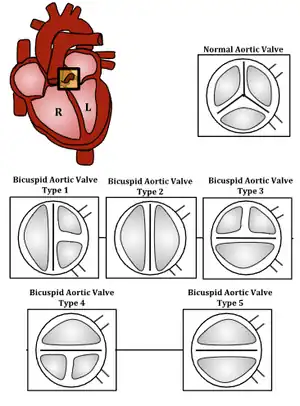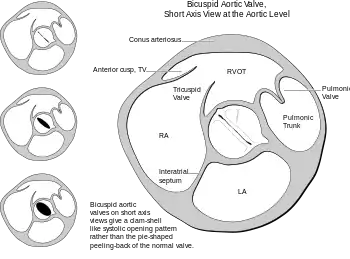Bicuspid aortic valve
| Bicuspid aortic valve | |
|---|---|
| Other names: Bicommissural aortic valve[1] | |
 | |
| The aortic valve controls outflow of blood from the left ventricle of the heart (valve is within the yellow box). Five types of bicuspid valve, with type 1 being most common. | |
| Specialty | Cardiology |
| Symptoms | Initially none[2] |
| Complications | Thoracic aortic aneurysm; aortic dissection; aortic stenosis; infective endocarditis; heart failure; sudden death[2] |
| Usual onset | Present at birth[2] |
| Causes | Genetic, spontaneous[2] |
| Diagnostic method | Ultrasound of the heart[2] |
| Treatment | Surveillance, screening of relatives, surgery[2] |
| Frequency | 1.5%[2] |
Bicuspid aortic valve (BAV) is a form of heart disease in which the aortic valve has two-leaflets (bicuspid) instead of the normal three-leaflet (tricuspid).[3] Initially there are generally no symptoms.[2] A heart murmur may be heard.[2] Over time complications may include thoracic aortic aneurysm, which occurs in half of people; aortic dissection; aortic stenosis or regurgitation; infective endocarditis; heart failure; and sudden death.[2][4]
It may be inherited from a person's parents, often in an autosomal dominant manner; though may also occur spontaneously.[2] Around 15% of cases occur within families.[2] It may occur as part of a number of syndromes including DiGeorge, Marfan, and Turner syndrome.[2] The underlying mechanism involves failure of two leaflets to separate during early development.[2] Diagnosis is generally by ultrasound of the heart.[2] Medical imaging of the upper aorta is recommended to rule out complications.[4] First-degree relatives should be tested for the condition.[2]
If initial imaging does not show any complications, further imaging should occur every 5 to 10 years.[2] Among those with an aortic aneurysm excise should be limited and surgery may be recommended before pregnancy.[2] Surgery is generally recommended if the aorta is over 5.0 cm (2.0 in) to 5.5 cm (2.2 in).[2] If surgery to repair the valve is required, replacement of the thoracic aorta may take place if it is greater than 4.0 cm (1.6 in) to 4.5 cm (1.8 in).[2][4]
Bicuspid aortic valve is the most common heart disease present at birth, affecting approximately 1.5% of people.[2][5] It occurs three times more often in males than females.[2] Sir William Osler first described the condition in 1886.[6]
Signs and symptoms
In many cases, a bicuspid aortic valve will cause no problems.[7] People may become tired more easily than those with normal valvular function and have difficulty maintaining stamina for cardio-intensive activities due to poor heart performance caused by stress on the aortic wall.[8][9]
Calcification
BAV may become calcified later in life, which may lead to varying degrees of severity of aortic stenosis that will manifest as murmurs.[10] If the leaflets do not close correctly, aortic regurgitation can occur.[10] If these become severe enough, they may require heart surgery. The heart is put under more stress in order to either pump more blood through a stenotic valve or attempt to circulate regurgitation blood through a leaking valve. Ultimately there is a risk of rupture in the aortic valve due to bicuspid aortopathy which is a result of progressive aortic dilation from the stress of having only two valve leaflets where three are normal.[11][12][13]
Aortic lesions
One of the most notable complications is the tendency to develop ascending aortic aneurysmal lesions. The extracellular matrix of the aorta in people with BAV shows marked deviations from that of the normal tricuspid aortic valve.
It is currently believed that an increase in the ratio of MMP2 (Matrix Metalloproteinases 2) to TIMP1 (tissue inhibitors of metalloproteinase) may be responsible for the abnormal degradation of the valve matrix and therefore lead to aortic dissection and aneurysm. However, other studies have also shown MMP9 involvement with no differences in TIMP expression. The size of the proximal aorta should be evaluated carefully during the workup. The initial diameter of the aorta should be noted and annual evaluation with CT scan, or MRI to avoid ionizing radiation, should be recommended to the patient; the examination should be conducted more frequently if a change in aortic diameter is seen. From this monitoring, the type of surgery that should be offered to the patient can be determined based on the change in size of the aorta.
Aortic narrowing
A bicuspid aortic valve may cause the heart's aortic valve to narrow (aortic stenosis).[10] This narrowing prevents the valve from opening fully, which reduces or blocks blood flow from the heart to the body. In some cases, the aortic valve does not close tightly, causing blood to leak backward into the left ventricle.[14]
Coarctation of the aorta (a congenital narrowing in the region of the ductus arteriosus) has also been associated with BAV.[15]
Pathophysiology

Fusion of aortic valve leaflets occurs most commonly (≈80%) between the right coronary and left coronary leaflets (RL), which are the anterior leaflets of the aortic valve.[16][17] Fusion also occurs between the right coronary and noncoronary leaflets (RN, ≈17%), and least commonly between the noncoronary and left coronary leaflets (≈2%).[16][17] In comparison to other fusion patterns, RN leaflet fusion has a stronger association with future complications such as aortic valve regurgitation and stenosis.[18][19] However, all fusion patterns associate with a specific area or areas of dilated enlargement in either the root of the ascending aorta, the ascending aorta, or the transverse aortic arch.[16][17][18][20]
Hemodynamics
Identifying hemodynamic patterns in the aorta after left ventricle systole aids in predicting consequential complications of bicuspid aortic valve.[16][17][18] The patient-specific risk of developing complications such as aortic aneurysms is dependent on the particular aortic leaflet fusion pattern, with each pattern varying in 4D MRI measurements of wall shear stress (WSS), blood flow velocity, asymmetrical flow displacement and flow angle of the aorta.[16][17][20]
BAV outflow is helical and occurs at high velocities (>1 m/s) throughout the ascending aorta.[16][17][18] This is potentially more damaging to the aorta in comparison to the streamline flow and short-lived burst of high velocity at the beginning of the aorta, as seen within a healthy tricuspid valve.[16] This eccentric outflow from the BAV results in blood hitting and reflecting off the aortic wall in a non-streamline fashion.[16][17] The specific zones where blood hits is dependent on the varying BAV leaflet fusion patterns and consequently correlates with increases in WSS.[16][20] WSS measurements in RL fusion indicate an increase in pressure applied predominantly to the right-anterior side of the vessel wall, while RN fusion increases WSS on the right-posterior wall.[16][20] The resulting rise in WSS is supported by the asymmetrical displacement of blood flow produced by an increased angle of outflow from the BAV.[16][17] Displacement is measured as the distance in millimeters from the center of the aorta to the center of the high velocity outflow.[16] Blood does not flow centrally through the aorta in BAV, but along the right-anterior and right-posterior vessel wall for RL and RN leaflet fusion respectively.[16][17]
Aortic disease
Identification of hemodynamics for RL, RN, and left coronary and noncoronary leaflet fusion patterns enables detection of specific aortic regions susceptible to dysfunction and the eventual development of disease.[16][17] Specifically, RL and RN fusion patterns are more likely to develop into these aortic disease states.[16][17] The blood flow information associated with RL fusion causes dilation of the mid-ascending aorta, while RN fusion is associated with dilation in the root, distal ascending aorta and transverse arch.[16][18] BAV helical and high velocity outflow patterns are consistent with aortic dilation hemodynamics seen in those with tricuspid aortic valves.[21] However, it is the increase and variance in WSS and flow displacement in BAV that demonstrate the importance of aortic leaflet morphology.[16] Flow displacement measurements taken from 4D MRI may be best for detecting irregularities in hemodynamics.[16] Displacement measurements were highly sensitive and distinguishable between different valve morphologies.[16] Hemodynamic measurements from 4D MRI in patients with BAV are advantageous in determining the timing and location of repair surgery to the aorta in aortopathy states.[16]
Most patients with bicuspid aortic valve whose valve becomes dysfunctional will need careful follow-up and potentially valve replacement at some point in life. Regular EchoCG and MRI may be performed.If the valve is normally functioning or minimally dysfunctional, average lifespan is similar to that of those without the anomaly.[22]
 Non‐mineralised tricuspid aortic valve (left) and stenotic mineralised tricuspid (middle) and bicuspid (right) aortic valves.
Non‐mineralised tricuspid aortic valve (left) and stenotic mineralised tricuspid (middle) and bicuspid (right) aortic valves.
Diagnosis
A bicuspid aortic valve can be associated with a heart murmur located at the right second intercostal space. Often there will be differences in blood pressures between upper and lower extremities. The diagnosis can be assisted with echocardiography or magnetic resonance imaging (MRI). Four-dimensional magnetic resonance imaging (4D MRI) is a technique that defines blood flow characteristics and patterns throughout the vessels, across valves, and in compartments of the heart.[16][17][23] Four-dimensional imaging enables accurate visualizations of blood flow patterns in a three-dimensional (3D) spatial volume, as well as in a fourth temporal dimension.[16][18][21][23] Current 4D MRI systems produces high-resolution images of blood flow in just a single scan session.[16][23]
_(1).png.webp) Transesophageal echocardiography- the right side commissure of the bicuspid aortic valve is ruptured
Transesophageal echocardiography- the right side commissure of the bicuspid aortic valve is ruptured Heart bicuspid aortic valve diagram
Heart bicuspid aortic valve diagram
Classification
Bicuspid aortic valves may assume three different types of configuration:[24]
- "Real" bicuspid valves with two symmetric leaflets
- A tricuspid architecture with a fusion of two leaflets
- A tricuspid architecture with a fusion of three leaflets
Screening
About 25% of first degree relatives of an affected individual also have the condition.[3]
Management
If initial imaging does not show any complications, further imaging should occur every 5 to 10 years.[2] If the aorta is over 4.5 cm than imaging should occur yearly.[3]
Complications stemming from structural heart issues are most often treated with surgery, which could include aortic valve replacement, or balloon valvuloplasty.[25]
Prognosis
BAV leads to significant complications in over one-third of affected individuals.[26] Complications include narrowing of the aortic valve opening, backward blood flow at the aortic valve, dilation of the ascending aorta, and infection of the heart valve.[26]
If aortic regurgitation and dilation of the ascending aorta are noted, they should undergo yearly surveillance with transthoracic echocardiograms if the aortic root measures 4.5 centimeters or greater in diameter.
Epidemiology
Bicuspid aortic valves are the most common cardiac valvular anomaly, occurring in 0.5% to 2% of the general population.[5] It is twice as common in males as in females.[27]
Bicuspid aortic valve is a heritable condition, with a demonstrated association with mutations in the NOTCH1 gene.[28] Its heritability () is as high as 89%.[29] Both familial clustering and isolated valve defects have been documented. Recent studies suggest that BAV is an autosomal dominant condition with incomplete penetrance. Other congenital heart defects are associated with bicuspid aortic valve at various frequencies, including coarctation of the aorta.[30]
Bicuspid aortic valve abnormality is also the most observed cardiac defect in Turner syndrome.
See also
References
- ↑ "Bicuspid aortic valve : MedlinePlus Medical Encyclopedia". medlineplus.gov. Archived from the original on 2 September 2019. Retrieved 27 May 2019.
- 1 2 3 4 5 6 7 8 9 10 11 12 13 14 15 16 17 18 19 20 21 22 23 Shah, Shailee Y.; Higgins, Andrew; Desai, Milind Y. (October 2018). "Bicuspid aortic valve: Basics and beyond". Cleveland Clinic Journal of Medicine. 85 (10): 779–784. doi:10.3949/ccjm.85a.17069. PMID 30289756.
- 1 2 3 Mubarik, A; Sharma, S; Law, MA (January 2023). "Bicuspid Aortic Valve". PMID 30480953.
{{cite journal}}: Cite journal requires|journal=(help) - 1 2 3 Isselbacher, Eric M. (15 February 2005). "Thoracic and Abdominal Aortic Aneurysms". Circulation. 111 (6): 816–828. doi:10.1161/01.CIR.0000154569.08857.7A.
- 1 2 Hraska, Viktor; Block, Joseph R. (2020). "91. Congenital valvular and supravalvular aortic stenosis". In Raja, Shahzad G. (ed.). Cardiac Surgery: A Complete Guide. Switzerland: Springer. pp. 829–838. ISBN 978-3-030-24176-6. Archived from the original on 2023-06-30. Retrieved 2023-05-29.
- ↑ Vojacek, Jan; Zacek, Pavel; Dominik, Jan; Holubek, Tomas (2018). "6. Congenital anomalies of the aortic valve". In Vojacek, Jan; Zacek, Pavel; Dominik, Jan (eds.). Aortic Regurgitation. Springer. p. 43. ISBN 978-3-319-74213-7. Archived from the original on 2023-06-30. Retrieved 2023-05-29.
- ↑ "Atrial Septal Defect". Commonly Asked Questions About Children and Heart Disease. October 29, 2012. Archived from the original on April 13, 2014. Retrieved April 9, 2014.
- ↑ Maredia A.K., Greenway S.C., Verma S., Fedak P.W.M. Bicuspid aortic valve-associated aortopathy: Update on biomarkers. Curr. Opin. Cardiol.. 2018;33(2):134-139. doi:10.1097/HCO.0000000000000481
- ↑ Bissell MM, Hess AT, Biasiolli L,etal.Aortic dilation in bicuspid aortic valvedisease: flow pattern is a major contributor and differs with valve fusion type.Circ Cardiovasc Imaging 2013; 6:499 – 507.
- 1 2 3 Ward, C. (2000-01-01). "Clinical significance of the bicuspid aortic valve". Heart. 83 (1): 81–85. doi:10.1136/heart.83.1.81. ISSN 1355-6037. PMC 1729267. PMID 10618341. Archived from the original on 2022-09-11. Retrieved 2022-10-02.
- ↑ Maredia A.K., Greenway S.C., Verma S., Fedak P.W.M. Bicuspid aortic valve-associated aortopathy: Update on biomarkers. Curr. Opin. Cardiol.. 2018;33(2):134-139. doi:10.1097/HCO.0000000000000481
- ↑ Losenno KL, Goodman RL, Chu MWA. Bicuspid aortic valve disease andascending aortic aneurysms: gaps in knowledge. Hindawi 2012; 2012:145202 – 145218.
- ↑ Bissell MM, Hess AT, Biasiolli L,etal.Aortic dilation in bicuspid aortic valvedisease: flow pattern is a major contributor and differs with valve fusion type.Circ Cardiovasc Imaging 2013; 6:499 – 507.
- ↑ Aortic valve stenosis (AVS). American Heart Association. http://www.heart.org/HEARTORG/Conditions/CongenitalHeartDefects/AboutCongenitalHeartDefects/Aortic-Valve-Stenosis-AVS_UCM_307020_Article.jsp#.WclzKdjrvcs Archived 2018-06-27 at the Wayback Machine. Accessed December 23, 2018.
- ↑ Rison, S. C. G.; Locke, T. P.; Rosenthal, E.; Gandhi, S. (2012). "A man with hypertension and two murmurs". BMJ. 344 (feb15 1): e956. doi:10.1136/bmj.e956.
- 1 2 3 4 5 6 7 8 9 10 11 12 13 14 15 16 17 18 19 20 21 22 23 Mahadevia R, Barker AJ, Schnell S, et al. (February 2014). "Bicuspid aortic cusp fusion morphology alters aortic three-dimensional outflow patterns, wall shear stress, and expression of aortopathy". Circulation. 129 (6): 673–82. doi:10.1161/CIRCULATIONAHA.113.003026. PMC 3946057. PMID 24345403.
- 1 2 3 4 5 6 7 8 9 10 11 12 Bissell MM, Hess AT, Biasiolli L, et al. (July 2013). "Aortic dilation in bicuspid aortic valve disease: flow pattern is a major contributor and differs with valve fusion type". Circulation: Cardiovascular Imaging. 6 (4): 499–507. doi:10.1161/CIRCIMAGING.113.000528. PMC 3859916. PMID 23771987.
- 1 2 3 4 5 6 Hope MD, Hope TA, Meadows AK, et al. (April 2010). "Bicuspid aortic valve: four-dimensional MR evaluation of ascending aortic systolic flow patterns". Radiology. 255 (1): 53–61. doi:10.1148/radiol.09091437. PMID 20308444.
- ↑ Fernandes SM, Sanders SP, Khairy P, et al. (October 2004). "Morphology of bicuspid aortic valve in children and adolescents". Journal of the American College of Cardiology. 44 (8): 1648–51. doi:10.1016/j.jacc.2004.05.063. PMID 15489098.
- 1 2 3 4 Barker AJ, Lanning C, Shandas R (March 2010). "Quantification of hemodynamic wall shear stress in patients with bicuspid aortic valve using phase-contrast MRI". Annals of Biomedical Engineering. 38 (3): 788–800. doi:10.1007/s10439-009-9854-3. PMC 2872988. PMID 19953319.
- 1 2 Weigang E, Kari FA, Beyersdorf F, et al. (July 2008). "Flow-sensitive four-dimensional magnetic resonance imaging: flow patterns in ascending aortic aneurysms". European Journal of Cardio-Thoracic Surgery. 34 (1): 11–6. doi:10.1016/j.ejcts.2008.03.047. PMID 18515137.
- ↑ Michelena HI, Desjardins VA, Avierinos JF, et al. (May 2008). "Natural history of asymptomatic patients with normally functioning or minimally dysfunctional bicuspid aortic valve in the community". Circulation. 117 (21): 2776–84. doi:10.1161/CIRCULATIONAHA.107.740878. PMC 2878133. PMID 18506017.
- 1 2 3 Markl M, Chan FP, Alley MT, et al. (April 2003). "Time-resolved three-dimensional phase-contrast MRI". Journal of Magnetic Resonance Imaging. 17 (4): 499–506. doi:10.1002/jmri.10272. PMID 12655592.
- ↑ Kumme, Anja (2007). Klassifikation bikuspider Aortenklappen. OCLC 254078723.
- ↑ Mohler ER, et al. Management of thoracic aortic aneurysm in adults. https://www.uptodate.com/contents/search Archived 2022-10-03 at the Wayback Machine. Accessed December 23rd, 2018.
- 1 2 LaHaye, S; Lincoln, J; Garg, V (2014). "Genetics of valvular heart disease". Current Cardiology Reports (Review). 16 (6): 487. doi:10.1007/s11886-014-0487-2. PMC 4531840. PMID 24743897.
- ↑ Tzemos N, Therrien J, Yip J, et al. (September 2008). "Outcomes in adults with bicuspid aortic valves". JAMA. 300 (11): 1317–25. doi:10.1001/jama.300.11.1317. PMID 18799444.
- ↑ Garg V, Muth AN, Ransom JF, et al. (2005). "Mutations in NOTCH1 cause aortic valve disease". Nature. 437 (7056): 270–274. Bibcode:2005Natur.437..270G. doi:10.1038/nature03940. PMID 16025100.
- ↑ Cripe L, Andelfinger G, Martin LJ, Shooner K, Benson DW (July 2004). "Bicuspid aortic valve is heritable". Journal of the American College of Cardiology. 44 (1): 138–43. doi:10.1016/j.jacc.2004.03.050. PMID 15234422.
- ↑ Blackbourne, Lorne H.; Chhabra, Anikar, eds. (2002). "Congenital Heart Disease". Pathology Recall. Lippincott Williams & Wilkins. pp. 247–9. ISBN 978-0-7817-3406-6. Archived from the original on 2022-10-20. Retrieved 2022-10-02.
External links
| Classification | |
|---|---|
| External resources |